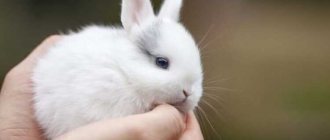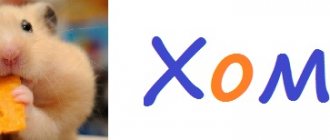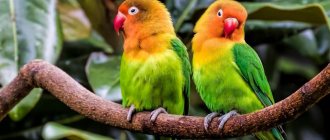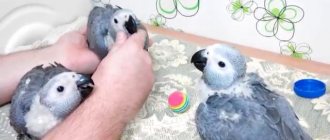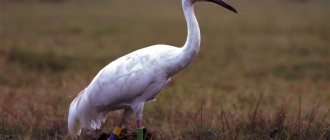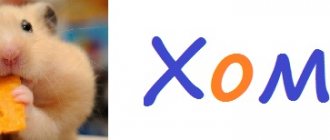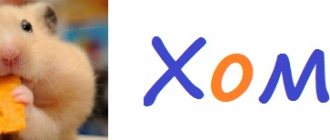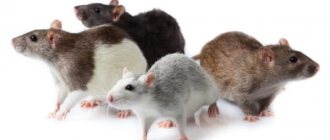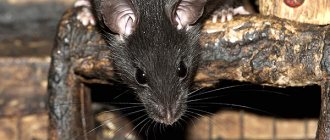Among the many species of ornamental birds, small parrots are the most sought after. This popularity is explained not only by the simplicity of maintenance, but also by the amount of positivity emanating from these birds. Miniature birds are funny, cute and smart. They are excellent conversationalists: they will always listen to their owner and even “support” the conversation. From this material you will learn about the tiniest parrots on the planet: what they look like, where they live in nature, how long they live and what conditions they need.
Budgerigar
The budgerigar is the most famous and popular species of small parrots. It is found in Australia. The budgerigar is easily tamed, is not shy and loves to communicate with people. Males easily learn to repeat words and phrases.
The size of the budgerigar is about 20 cm, body weight is 40-45 g. The natural color of the representatives of the species is green. The head and wings are yellow with a black wave-like pattern, the tail is turquoise. Breeders have bred many breeds that differ in color. The most popular are blue and yellow parrots.
The sex of a budgerigar can be easily determined by the color of the wax beak. In young males it is lilac, in adults it is bright blue. In young females the cere is blue with a light rim around the nostrils; in adult females ready for reproduction, it is brown.
Varieties of small parrots
Beginning breeders are recommended to have small parrots, since keeping and caring for them is not difficult compared to keeping large parrots. They are also quite easy to breed.
But the advantages of small parrots are obvious:
- take up little space;
- much less destructive and noisy than large species of parrots;
- food, a cage and accessories for it are quite affordable, many of them, for example, the same cage, can be made with your own hands;
- prices for small breeds of parrots are an order of magnitude lower than for other species.
Wavy
One of the most popular feathered pets is the Australian budgerigar. The natural color is light green, however, thanks to selection, about 200 color varieties can be found at home.
- Body dimensions from head to tail are only 17-19 cm, of which the tail accounts for more than half - 9-10 cm.
- Maximum weight 45 grams.
- Thanks to the wave stripes throughout the body, the birds got their name, although now there are also solid-colored varieties (yellow, blue, dark green, blue and others) that do not have these waves.
- They have a strong beak of small size.
- They are very fast in flight - in the wild, wild wavy birds can reach speeds of 120 km/h.
The lifespan of these active birds under good conditions can reach 15-20 years.
Budgerigars are excellent talkers. If you work with them, they are able to learn and readily reproduce several dozen words and phrases. True, only boys have this ability.
Quite a talkative and noisy species of bird. They can tweet all day long, deftly shouting over a running TV or people talking. Very playful and friendly. They are not particularly demanding in terms of living conditions and are excellent friends with children. By the way, if you are thinking about what kind of parrot to get for your child, a budgie is the best option.
Passeriformes
This species of small parrots, natives of America, is also easy to keep, but is not justifiably very popular among breeders.
The natural color of parrots is green. Thanks to selection, blue, cream and yellow birds appeared.
- The body size is no more than 14.5 cm - for the “passerine” size of the birds they were called passerines.
- Weight only 30 grams.
- The tail of birds is peculiar: short wedge-shaped or rounded.
- The beak is light, quite wide, and also widens on the sides.
Lovebirds
Lovebirds are small parrots that live in Africa and Madagascar. Representatives of this genus are characterized by strong affection between the male and female. In captivity, they can be kept in pairs or alone, but when kept alone, the owner must pay enough attention to the bird.
The body length of lovebirds reaches 10-17 cm, and their weight is 40-60 g. The body is strong, the head is large, the tail is short, and the beak is strong. Color depends on the species; most often the plumage contains green and yellow shades. The genus of lovebirds includes 9 species:
- collar;
- mask;
- red-faced;
- rosy-cheeked;
- grey-headed;
- black-cheeked;
- black-winged;
- Liliana;
- Fisher.
Lovebirds raised by their parents never become completely tame and cannot be trained. To get tame birds, it is necessary to take the chicks from the nest shortly before departure and feed them artificially. Such parrots become strongly attached to their owner, but require a lot of attention and cannot stand loneliness.
Where can I buy
You can buy a small parrot in a nursery, at the market or in a pet store, as well as from private owners. The cost of a budgerigar in nurseries varies from 600 to 5,000 rubles, and from a private owner you can buy a parrot from 500 to 2,000 thousand rubles.
The price for a lovebird varies from 1,500 to 6,000 thousand rubles, and prices are affected by the region of residence, age and other characteristics of the parrots. If you need to buy a passerine parrot, you will have to spend a large sum, since the price starts from 2.5 thousand rubles, which is due to the rarity of the breed.
Passerine parrot
Passerine parrots are small parrots native to Central and South America. Their body dimensions do not exceed 15 cm, and their weight is 30 g. The body is compact, the tail is short, and the beak is large. Color depends on the species. The natural color includes predominantly green shades, but breeders have developed blue, yellow and cream morphs.
The genus has 7 species:
- parakeet;
- yellow-faced parakeet;
- Mexican parakeet;
- Lesson's parakeet;
- spectacled parakeet;
- blue-winged parakeet;
- dark-billed parakeet.
All representatives of the genus are well tamed and willingly make contact with humans. They are social birds, so it is best to keep them in pairs; When kept alone, the owner must pay a lot of attention to the pet. Passerine parrots have a quiet voice and are not prone to excessive noise. They are able to remember and reproduce human speech (up to 10-15 words).
Choosing a small parrot
From the species of small parrots presented here, you can choose a pet according to your interests:
- if you love communication, constant liveliness in the house and want your pet to talk, get a budgie - you will like these talkers;
- if you want your house to be filled with chirping, but cannot devote much time to your pets, get a couple of lovebirds - you will get great pleasure watching these birds;
- If you don’t like noise and restless fuss, but are happy to play with your pets, get passerines - you will be interested in them, especially since one day they can speak, imitating human speech.
Parakeet
woodpecker parrot
The Woodpecker Parrot is the smallest parrot in the world. Lives in New Guinea and nearby islands. The body length of an adult does not exceed 10 cm, and the weight is 15 g. The body is compact, the head is large, the tail is short, shaped like a woodpecker’s tail. The color of the plumage is predominantly green; Depending on the species, the color may include red, blue, yellow, black and brown.
The genus of woodpecker parrots includes 6 species:
- Bruina;
- Finsha;
- Schlegel;
- Salvadori;
- Meeka;
- Sclater.
Woodpecker parrots get used to humans, but do not become completely tame. They cannot reproduce human speech. These birds should be kept in a spacious enclosure where they can fly. In nature, these parrots feed mainly on nectar, tree sap, fruits and soft shoots of plants. In captivity, their diet should consist of fresh fruits, greens and a liquid mixture of milk, wheat flour, and chopped nuts.
Fig parrot
Fig parrots are small parrots native to Australia and New Guinea. Their body dimensions do not exceed 14 cm, and their weight is 35 g. The genus includes 2 species: black-cheeked and golden-sided fig parrots. The main body color of representatives of both species is green. The golden-sided parakeet has yellow sides and blue and red feathers on its head and wings. The black-cheeked parrot has a white and blue head with black markings on the cheeks, a red breast, and blue feathers on the wings.
These birds are poorly tamed, do not learn human speech, and are rarely seen in captivity. The basis of their diet in nature is figs and nectar, as well as seeds, flowers, berries and fruits. When kept in captivity, it is important to provide adequate nutrition. Fig parrots will need a spacious cage or aviary where they can fly freely. They are kept in pairs or small groups. Birds have a quiet voice and are not prone to excessive noise.
Description
The habitat of parrots is the tropical and subtropical regions of America and Australia. Various species have their own special, unique color, size, and habits. These birds have won the hearts of bird lovers. And all thanks to their cheerful disposition, curiosity, restlessness, and positivity that they radiate to others.
Content Features
To keep a parrot you will need a rectangular cage. Its size should be such that the bird can freely spread its wings and fly from perch to perch. For ease of cleaning, you should choose a cage with a retractable tray. The cage contains:
- wooden perches of such a diameter that the parrot cannot completely wrap his fingers around them;
- two feeders - for dry and succulent food;
- drinking bowl;
- bathing suit;
- toys (wooden or rope);
- mineral supplements (sepia or special mineral stone).
The cage is placed near the wall at the level of the person’s face. It should not be in a draft or in the aisle. Tamed birds can be released from the cage to walk around the room. The water in the drinking bowl and bathing basin is changed daily or more often as it gets dirty. The diet should include:
- grain mixture;
- vegetables;
- fruits;
- greenery;
- boiled egg;
- low-fat cottage cheese;
- porridge cooked in water;
- insects
You can place branches of fruit trees in the cage, which serve as toys for parrots and a source of nutrients. In addition, birds are offered toys purchased at a pet store or home-made toys. They should be made from natural materials and not contain paint, which may be toxic to birds. Toys can be intended for:
- grinding off beak and claws;
- climbing and hanging (ropes, swings, ladders);
- environmental enrichment (educational toys).
On a note! Toys that make sounds are not recommended to be placed in a cage. They can cause stress in birds and also distract parrots from interacting with humans and remembering words.
Health and life expectancy
The lifespan of small feathered birds ranges from 5 to 20 years and depends on what species they belong to. Woodpeckers have the shortest lifespan. But these birds can live up to 15-18 years.
Small parrots do not have a strong immune system and often contract infections. Therefore, at the first symptoms of the disease or any deviations in the behavior of birds, you should contact a veterinarian.
Due to their small size, small parrots often get injured when they get tangled in curtains or bump into window frames. They may also be preyed upon by other pets or abused by their owner's children. Therefore, the bird should not be released from the cage unattended.
Small parrots are quite curious and often drown in pots of water, get poisonous fumes or get burned. They also have a weak heart and are prone to stress. That's why you should protect these birds from emotional outbursts.

